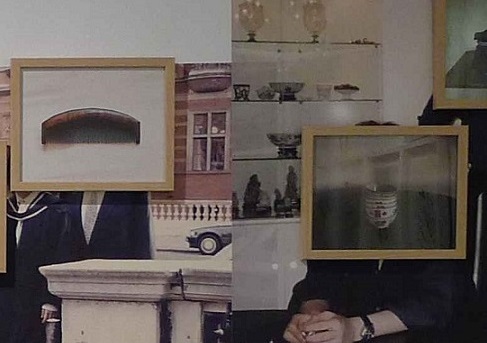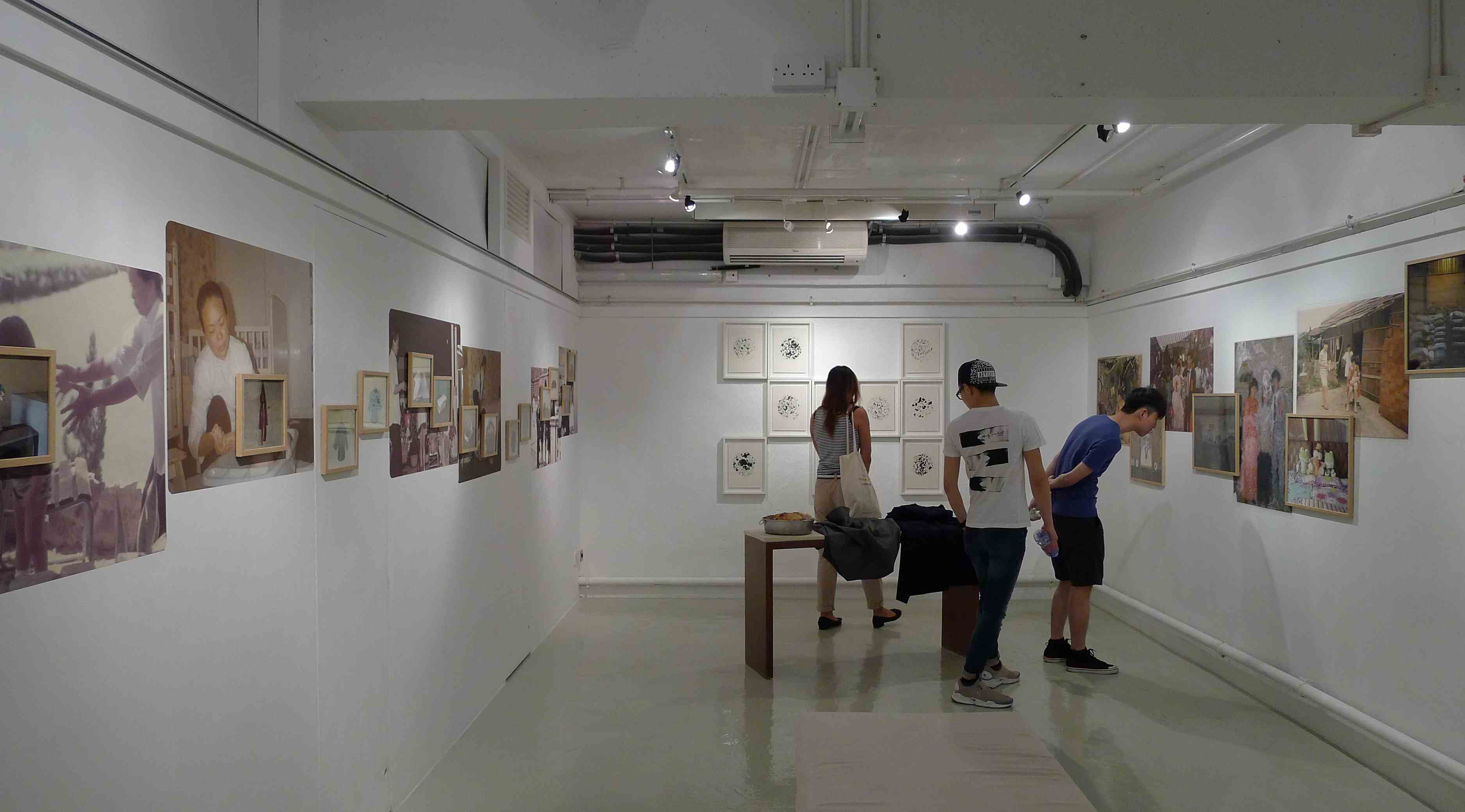New/Alternative Art Space
- LumenvisumKurt Tong: Threads of Sisterhood
John BATTEN
at 6:22pm on 16th November 2016


Captions:
1. - 2. Installation views of the exhibition and detail
(原文以英文發表,評論〈顏姐 - 唐景鋒個展〉。)
Hong Kong-born, English-educated, and not to be confused with the new U.S.A. consul general in Hong Kong & Macau, Kurt Tong (Tong King Fung) has explored in recent years his own identity and Hong Kong and Diaspora life. His large-scale ‘The Queen, the Chairman and I’ (2009-2012) exhibition has been shown around the world and was originally developed as a souvenir for his young daughters to help them appreciate their heritage and identity. As it evolved into a larger project and book, it also “spoke to the millions of Chinese who have escaped war, famine and Communism - or anyone in the world who has gone through migration and displacement.”
One small part of this earlier exhibition featured Mak Ngan Yuk, Tong’s nanny, who worked for his family for nearly 40 years. In ‘Threads of Sisterhood’, Mak takes centre-stage and we glimpse a little more of her life. Tong has skillfully created an installation of photographs, drawings and objects that subtly reflects Mak’s quiet and conscientious work for her adopted family and her central role as the main breadwinner for her family on the mainland. The dual role of being a ‘secondary’ employee but ‘pivotal’ absent family member continues to resonate with Hong Kong’s legions of female, domestic workers.
Now aged eighty-seven years, Mak was the eldest in a poor farming family near Zhongshan, Guangdong. She was denied schooling because of her gender and was tasked to care for her younger siblings and work in the nearby mulberry, silk producing, fields. She wished to learn and began paying for her own schooling, but after her father found out she was told that she “should be paying for her brothers, instead of wasting it on herself.” As she grew older, pressure to be married before her younger brothers grew. Mak did not want to be forced into an arranged marriage, so decided to become independent and performed a “comb up ceremony”, confirming her spinsterhood and having her hair tied in a bun.
The origins of the ceremony date from the start of the Qing Dynasty, when woman worked in the mulberry fields and earned good wages from the then-booming silk trade. As a sign of independence before marriage, women would wear their hair in a long braid. As the silk trade declined in the late 19th century, many women sought employment elsewhere in Asia. The later comb up ceremony “involved bathing in mulberry leaves and a fellow ‘sister’ would braid their hair. From that day on, they could only wear a light colour tunic and dark trousers. They would take the chastity vow and have no further obligations towards their parents….the combed up women would look after each other ” and in old age some lived together in “sisterhood homes.”
Mak arrived in Hong Kong and worked as an amah for only two families over the next 55 years. Tong begins the exhibition with the few photographs that Mak has of herself – passport photos arranged in the order of her age at the time. A strong narrative is built around old family photographs depicting the Tong family with Mak seen on the edges of photographs or working, caring for children. Tong purposely covers these images of himself and his family with framed photographs of Mak’s simple possessions – her protective-cloth covered telephone, a teacup, a set of double-happiness bowls. These family photographs no longer are of his family, but reworked as a strongly felt homage to Mak’s “hard working, selfless and independent personalities.”
Mak regularly returned to China “and kept her family alive through the great famine of the 1950s, paid for all her nephew and nieces’ educations, built several houses in her home village for her aunts, brothers and nephews and supported her nephew’s businesses.” In the centre of the gallery is a poignant installation of hand-sewn cloth bags, in which Mak brought goods to her family and they could unstitch and reuse as much-needed cloth to make clothes. A wall of drawings by Tong of cakes of hard-burnt rice, the only food allowed into the mainland for a time, reminds of the ordeals of survival.
A final wall of photographs of Mak’s family gatherings and wedding celebrations emphasises the stoic simplicity of Mak Ngan Yuk’s own life. The exhibition’s final powerful recent photograph of Mak standing in her village ”symbolizes the last generation of comb-up women, hard working, selfless and independent.”
Link for further info:
‘Threads of Sisterhood’ @ Lumenvisum
A version of this review was published in the South China Morning Post, 4 November 2016.
原文刊於《南華早報》,2016年11月4日。
1. - 2. Installation views of the exhibition and detail
(原文以英文發表,評論〈顏姐 - 唐景鋒個展〉。)
Hong Kong-born, English-educated, and not to be confused with the new U.S.A. consul general in Hong Kong & Macau, Kurt Tong (Tong King Fung) has explored in recent years his own identity and Hong Kong and Diaspora life. His large-scale ‘The Queen, the Chairman and I’ (2009-2012) exhibition has been shown around the world and was originally developed as a souvenir for his young daughters to help them appreciate their heritage and identity. As it evolved into a larger project and book, it also “spoke to the millions of Chinese who have escaped war, famine and Communism - or anyone in the world who has gone through migration and displacement.”
One small part of this earlier exhibition featured Mak Ngan Yuk, Tong’s nanny, who worked for his family for nearly 40 years. In ‘Threads of Sisterhood’, Mak takes centre-stage and we glimpse a little more of her life. Tong has skillfully created an installation of photographs, drawings and objects that subtly reflects Mak’s quiet and conscientious work for her adopted family and her central role as the main breadwinner for her family on the mainland. The dual role of being a ‘secondary’ employee but ‘pivotal’ absent family member continues to resonate with Hong Kong’s legions of female, domestic workers.
Now aged eighty-seven years, Mak was the eldest in a poor farming family near Zhongshan, Guangdong. She was denied schooling because of her gender and was tasked to care for her younger siblings and work in the nearby mulberry, silk producing, fields. She wished to learn and began paying for her own schooling, but after her father found out she was told that she “should be paying for her brothers, instead of wasting it on herself.” As she grew older, pressure to be married before her younger brothers grew. Mak did not want to be forced into an arranged marriage, so decided to become independent and performed a “comb up ceremony”, confirming her spinsterhood and having her hair tied in a bun.
The origins of the ceremony date from the start of the Qing Dynasty, when woman worked in the mulberry fields and earned good wages from the then-booming silk trade. As a sign of independence before marriage, women would wear their hair in a long braid. As the silk trade declined in the late 19th century, many women sought employment elsewhere in Asia. The later comb up ceremony “involved bathing in mulberry leaves and a fellow ‘sister’ would braid their hair. From that day on, they could only wear a light colour tunic and dark trousers. They would take the chastity vow and have no further obligations towards their parents….the combed up women would look after each other ” and in old age some lived together in “sisterhood homes.”
Mak arrived in Hong Kong and worked as an amah for only two families over the next 55 years. Tong begins the exhibition with the few photographs that Mak has of herself – passport photos arranged in the order of her age at the time. A strong narrative is built around old family photographs depicting the Tong family with Mak seen on the edges of photographs or working, caring for children. Tong purposely covers these images of himself and his family with framed photographs of Mak’s simple possessions – her protective-cloth covered telephone, a teacup, a set of double-happiness bowls. These family photographs no longer are of his family, but reworked as a strongly felt homage to Mak’s “hard working, selfless and independent personalities.”
Mak regularly returned to China “and kept her family alive through the great famine of the 1950s, paid for all her nephew and nieces’ educations, built several houses in her home village for her aunts, brothers and nephews and supported her nephew’s businesses.” In the centre of the gallery is a poignant installation of hand-sewn cloth bags, in which Mak brought goods to her family and they could unstitch and reuse as much-needed cloth to make clothes. A wall of drawings by Tong of cakes of hard-burnt rice, the only food allowed into the mainland for a time, reminds of the ordeals of survival.
A final wall of photographs of Mak’s family gatherings and wedding celebrations emphasises the stoic simplicity of Mak Ngan Yuk’s own life. The exhibition’s final powerful recent photograph of Mak standing in her village ”symbolizes the last generation of comb-up women, hard working, selfless and independent.”
Link for further info:
‘Threads of Sisterhood’ @ Lumenvisum
A version of this review was published in the South China Morning Post, 4 November 2016.
原文刊於《南華早報》,2016年11月4日。
